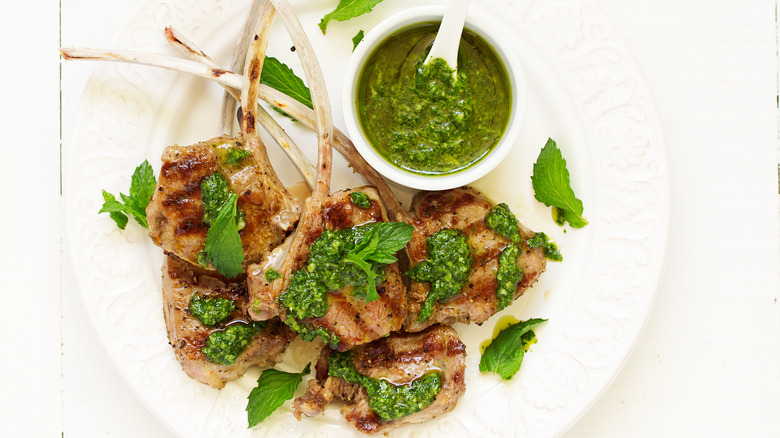The Royal Decree That Introduced Mint Sauce To Lamb
A sure sign of spring and a feature on Easter supper tables is a rack of lamb. Lamb is a sheep that's been slaughtered before it's a year old, while mutton is meat from an older sheep. Both lamb and mutton are on the gamier side of meat, so it benefits greatly from condiments that balance that gaminess — think herby chimichurris, lemony sauces, or even a cooling tzatziki sauce (via The Kitchn).
A classic pairing with a rack of lamb or a chop is a mint sauce. Mint is one of the first plants to bloom in spring, which is also when lambs are brought to slaughter. The herb has many applications in the kitchen, from sweet to savory. When paired with lamb, it enhances the flavor of the meat and cuts through the gaminess. Washington State Magazine reports that many recipes for a mint sauce to accompany lamb feature "finely chopped mint leaves, vinegar, and sugar," with early iterations appearing in an 1828 cookbook.
In modern times, we don't really question the why of pairing lamb and mint — we know they work together and they're delicious, but what does Queen Elizabeth I have to do with why we pair a mint sauce with lamb?
Sheep were more useful alive than on a dinner plate
But first, a quick history lesson — wool was a major commodity in Elizabethan England. According to Tudor Times, a man who died in 1521 left behind 15,500 sheep. In the 1540s, an estimated 50,723 sacks of wool (equal to 10,700,000 sheep) were produced per year in England and Wales. Meat was considered a less important product than the textile and came from sheep whose wool quality wasn't up to snuff anymore. Wanting to prevent perfectly good lambs and sheep from being slaughtered for meat instead of kept alive for wool, Queen Elizabeth I issued a royal decree that lamb and mutton could only be eaten with bitter herbs, Washington State Magazine reports. Enterprising chefs and cooks in medieval England took up the challenge and created mint sauce.
Middle Eastern and North African cuisines also count mutton as an important protein, where it's also traditionally served with a minty yogurt sauce. According to Washington State Magazine, A mint and olive oil dip for mutton has been around since the Ancient Greeks, and now Greeks eat 30 times more lamb than Americans do.

